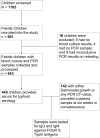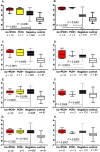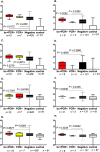Ascertaining the burden of invasive Salmonella disease in hospitalised febrile children aged under four years in Blantyre, Malawi
- PMID: 31314752
- PMCID: PMC6663031
- DOI: 10.1371/journal.pntd.0007539
Ascertaining the burden of invasive Salmonella disease in hospitalised febrile children aged under four years in Blantyre, Malawi
Abstract
Typhoid fever is endemic across sub-Saharan Africa. However, estimates of the burden of typhoid are undermined by insufficient blood volumes and lack of sensitivity of blood culture. Here, we aimed to address this limitation by exploiting pre-enrichment culture followed by PCR, alongside routine blood culture to improve typhoid case detection. We carried out a prospective diagnostic cohort study and enrolled children (aged 0-4 years) with non-specific febrile disease admitted to a tertiary hospital in Blantyre, Malawi from August 2014 to July 2016. Blood was collected for culture (BC) and real-time PCR after a pre-enrichment culture in tryptone soy broth and ox-bile. DNA was subjected to PCR for invA (Pan-Salmonella), staG (S. Typhi), and fliC (S. Typhimurium) genes. A positive PCR was defined as invA plus either staG or fliC (CT<29). IgM and IgG ELISA against four S. Typhi antigens was also performed. In total, 643 children (median age 1.3 years) with nonspecific febrile disease were enrolled; 31 (4.8%) were BC positive for Salmonella (n = 13 S. Typhi, n = 16 S. Typhimurium, and n = 2 S. Enteritidis). Pre-enrichment culture of blood followed by PCR identified a further 8 S. Typhi and 15 S. Typhimurium positive children. IgM and IgG titres to the S. Typhi antigen STY1498 (haemolysin) were significantly higher in children that were PCR positive but blood culture negative compared to febrile children with all other non-typhoid illnesses. The addition of pre-enrichment culture and PCR increased the case ascertainment of invasive Salmonella disease in children by 62-94%. These data support recent burden estimates that highlight the insensitivity of blood cultures and support the targeting of pre-school children for typhoid vaccine prevention in Africa. Blood culture with real-time PCR following pre-enrichment should be used to further refine estimates of vaccine effectiveness in typhoid vaccine trials.
Conflict of interest statement
The authors have declared that no competing interests exist.
Figures





References
-
- Gordon MA, Graham SM, Walsh AL, Wilson L, Phiri A, Molyneux E, et al. Epidemics of invasive Salmonella enterica serovar enteritidis and S. enterica Serovar typhimurium infection associated with multidrug resistance among adults and children in Malawi. Clinical infectious diseases: an official publication of the Infectious Diseases Society of America. 2008;46(7):963–9. - PubMed
Publication types
MeSH terms
Substances
Grants and funding
LinkOut - more resources
Full Text Sources
Medical

